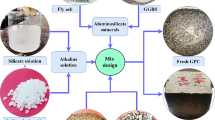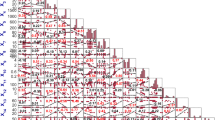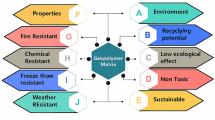Abstract
This study aims to propose an efficient technique for improving the compressive strength of geopolymer concrete using Flyash and GGBS. Various regression models, including linear regression, lasso regression, and ridge regression, were compared to predict the compressive strength. The research holds significance in understanding the strengths and limitations of these regression techniques for real-world data scenarios, aiding data scientists and promoting advancements in machine learning. The outcomes can have practical implications in various domains, enhancing knowledge and comprehension of regression techniques and their applications. The dataset consisted of 147 samples with 11 independent variables and 1 dependent variable, and statistical measurements, such as MSE, MAE, and RMSE, were used to evaluate the accuracy of the models. These findings underscore the importance of selecting the appropriate regression model tailored to the specific dataset to ensure accurate predictions and reliable insights. Based on these findings, it can be concluded that the Linear Regression model is the most suitable for predicting compressive strength based on the given dataset. However, further research and analysis may be required to explore additional factors that could improve the accuracy of the models and enhance the understanding of the relationship between the independent variables and compressive strength.




Similar content being viewed by others
Data availability
All data generated or analyzed in the research discussed in the manuscript.
References
Akgün, B., & Öǧüdücü, Ş.G. (2015) ‘Streaming linear regression on spark MLlib and MOA’, in Proceedings of the 2015 IEEE/ACM International Conference on Advances in Social Networks Analysis and Mining, ASONAM 2015. Association for Computing Machinery, Inc, pp. 1244–1247. Available at: https://doi.org/10.1145/2808797.2809374.
Bickel, P. et al. (no date) Springer Series in Statistics. Available at: http://www.springer.com/series/692.
Chai, T., & Draxler, R.R. (2014) ‘Root mean square error (RMSE) or mean absolute error (MAE)? -Arguments against avoiding RMSE in the literature’, Geoscientific Model Development, 7(3), pp. 1247–1250. Available at: https://doi.org/10.5194/gmd-7-1247-2014.
Chouksey, A. et al. (2022) An investigation on the effect of curing conditions on the mechanical and microstructural properties of the geopolymer concrete. Materials Research Express, 9(5), p. 55003. Available at: https://doi.org/10.1088/2053-1591/ac6be0.
Christopher H. Achen (1982) ‘Interpreting and Using Regression’, SAGE Publications, Inc. [Preprint].
Davidovits, J. (1989). Geopolymers and geopolymeric materials. Journal of Thermal Analysis, 35(1989), 429–441.
Davidovits, J. (1991). Geopolymers inorganic polymeric new materials. Journal of Thermal Analysis, 37, 1633–1656.
Davidovits, J. (2002) 30 Years of Successes and Failures in Geopolymer Applications. Market Trends and Potential Breakthroughs. In Geopolymer 2002 Conference, October 28–29, 2002, Melbourne, Australia, pp. 1–16. Available at: www.geopolymer.org.
Davidovits, J. (2015) Geopolymer Chemistry & Applications.
Gupta, P. K., Rakesh Kumar, Y. K., & Gupta, P. K. M. (2017). Effect of Acidic Environment on Self Compacting Concrete. International Journal of Civil Engineering and Technology (IJCIET), 8(2), 595–606.
Isabona, J. (2015) A least absolute deviation tuning method to reduce signal coverage loss prediction error in electromagnetic wave propagation channel Practical approach for Service Quality Monitoring in cellular Mobile Broadband Networks View project Computational intelligence View project. Available at: https://www.researchgate.net/publication/304490450.
Kaveh, A., & Iranmanesh, A. (1998). Comparative Study of Backpropagation and Improved Counterpropagation Neural Nets in Structural Analysis and Optimization. International Journal of Space Structure, 13(4), 177–185.
Kaveh, A., Gholipour, Y., & Rahami, H. (2008). Optimal design of transmission owers using genetic algorithm and neural networks. International Journal of Space Structure, 23(1), 1–20.
Kaveh, A., & Khalegi, A. (1998) ‘Prediction of strength for concrete specimens using artificial neural networks’, Asian Journal of Civil Engineering, 2, pp. 1–13. Available at: https://hero.epa.gov/hero/index.cfm/reference/details/reference_id/6859258 (Accessed: 17 April 2023).
Kaveh, A., & Khavaninzadeh, N. (2023). Efficient training of two ANNs using four meta-heuristic algorithms for predicting the FRP strength. Structures, 52(March), 256–272.
Kaveh, A., & Servati, H. (2001). Design of double layer grids using backpropagation neural networks. Computers & Structures, 79, 1561–1568.
Kosmatka, S.H., Kerkhoff, Beatrix., & Panarese, W.C. (2002) Design and control of concrete mixtures. Portland Cement Association.
Krithika, J., & Ramesh Kumar, G.B. (2020) ‘Influence of fly ash on concrete - A systematic review’, in Materials Today: Proceedings. Elsevier Ltd, pp. 906–911. Available at: https://doi.org/10.1016/j.matpr.2020.06.425.
‘kullback1951’ (no date).
Kumar, N. et al. (2023a) ‘Environmental Concern in TPB Model for Sustainable IT Adoption’, in International Conference on Information Systems and Intelligent Applications, Lecture Notes in Networks and Systems 550, pp. 59–70. Available at: https://doi.org/10.1007/978-3-031-16865-9_5.
Kumar, R. et al. (2022) ‘Influence of chloride and sulfate solution on the long‐term durability of modified rubberized concrete’, Journal Of Applied Polymer Science, (139), pp. 1–15. Available at: https://doi.org/10.1002/app.52880.
Kumar, R. et al. (2023b) ‘Investigation of dry-wet cycles effect on the durability of modified rubberised concrete’, Forces in Mechanics, 10(2023b), p. 100168. Available at: https://doi.org/10.1016/j.finmec.2023.100168.
Kumar, R., Verma, M., & Dev, N. (2022) ‘Investigation on the Effect of Seawater Condition, Sulphate Attack, Acid Attack, Freeze–Thaw Condition, and Wetting–Drying on the Geopolymer Concrete’, Iranian Journal of Science and Technology Transactions of Civil EngineeringTransactions of Civil Engineering, 46(4), pp. 2823–2853. Available at: https://doi.org/10.1007/s40996-021-00767-9.
Mazzotti, M., et al. (2005). Mineral carbonation and industrial uses of carbon dioxide. Cambridge University Press.
Mai, H. V. T., et al. (2021). ‘Prediction Compressive Strength of Concrete Containing GGBFS using Random Forest Model’, Advances in Civil Engineering, 2021. Available at: https://doi.org/10.1155/2021/6671448
Maulud, D., & Abdulazeez, A.M. (2020) ‘A Review on Linear Regression Comprehensive in Machine Learning’, Journal of Applied Science and Technology Trends, 1(4), pp. 140–147. Available at: https://doi.org/10.38094/jastt1457.
Mcdonald, G.C. (no date) ‘Ridge regression’. Available at: https://doi.org/10.1002/wics.014.
Nigam, M., & Verma, M. (2023) ‘Effect of Nano-Silica on the fresh and Mechanical Properties of Conventional Concrete’, Forces in Mechanics, 10(22), p. 100165. Available at: https://doi.org/10.1016/j.finmec.2022.100165.
Problems, N., Hoerl, A.E., & Kennard, R.W. (2000) American Society for Quality Ridge Regression: Biased Estimation for.
Provis, J. L., et al. (2009). Geopolymers Structure, processing, properties and industrial applications, CRC Press Boca Raton Boston New York Washington. DC. Available at: https://doi.org/10.1016/0375-9601(81)90388-1
Provis, J.L., & Van Deventer, J.S.J. (2014) Alkali Activatd Materials State-of-the-Art Report, RILEM TC 224-AAM. Springer Dordrecht Heidelberg New York London. Available at: https://doi.org/10.1007/978-94-007-7672-2.
Roopa, H., & Asha, T. (2019) ‘A Linear Model Based on Principal Component Analysis for Disease Prediction’, IEEE Access, 7, pp. 105314–105318. Available at: https://doi.org/10.1109/ACCESS.2019.2931956.
Santos, M., & Mateus, R. (no date) Master Degree Program in Data Science and Advanced Analytics prediction of high-performance concrete compressive strength through a comparison of machine learning techniques MDSAA.
Sarojamma, B. (2018) A study on comparison among ridge, lasso, and elastic net regressions. Available at: www.ijcrt.org.
Schneider, A., Hommel, G., & Blettner, M. (2010) ‘Lineare regressionsanalyse - Teil 14 der serie zur bewertung wissenschaftlicher publikationen’, Deutsches Arzteblatt, pp. 776–782. Available at: https://doi.org/10.3238/arztebl.2010.0776.
Sharma, U., Gupta, N., & Verma, M. (2023) ‘Prediction of Compressive Strength of Geopolymer Concrete using Artificial Neural Network’, Asian Journal of Civil Engineering, pp. 1–14. Available at: https://doi.org/10.1007/s42107-023-00678-2.
Shewhart, W.A. et al. (2003) Wiley series in probability and statistics. Available at: www.copyright.com.
Stanton, J. M. (2001). ‘Galton, Pearson, and the Peas: A Brief History of Linear Regression for Statistics Instructors’, Journal of Statistics Education, 9(3). Available at: https://doi.org/10.1080/10691898.2001.11910537
Thiyagarajan, S.V., R, T., & Doddurani, M. (2013) ‘Analyzing the Behaviour of Concrete with Waste Ceramic as Fine Aggregate’, i-manager’s Journal on Civil Engineering, 3, pp. 25–29. Available at: https://doi.org/10.26634/jce.3.1.2153.
Upreti, K. et al. (2022) ‘Prediction of Mechanical Strength by Using an Artificial Neural Network and Random Forest Algorithm’, Journal of Nanomaterials, 2022, pp. 1–12. Available at: https://doi.org/10.1155/2022/7791582.
Upreti, K., & Verma, M. (2022) ‘Prediction of compressive strength of high-volume fly ash concrete using artificial neural network’, Journal of Engineering Research and Application, 1(December), pp. 24–32. Available at: https://doi.org/10.55953/JERA.2022.2104.
Verma, M., Upreti, K., et al. (2022a) ‘Experimental Analysis of Geopolymer Concrete : A Sustainable and Economic Concrete Using the Cost Estimation Model’, Advances in Materials Science and Engineering, 2022a, pp. 1–16. Available at: https://doi.org/10.1155/2022/7488254.
Verma, M., Dev, N., et al. (2022b) ‘Geopolymer Concrete: A Material for Sustainable Development in Indian Construction Industries’, Crystals, 12(2022b), p. 514. Available at: https://doi.org/10.3390/cryst12040514.
Verma, M. (2023a) ‘Prediction of compressive strength of geopolymer concrete by using ANN and GPR’, Asian Journal of Civil Engineering, pp. 1–9. Available at: https://doi.org/10.1007/s42107-023-00676-4.
Verma, M., Upreti, K., Khan, M.R., et al. (2023a) ‘Prediction of Compressive Strength of Geopolymer Concrete by Using Random Forest Algorithm’, in ICACIS 2022, pp. 170–179. Available at: https://doi.org/10.1007/978-3-031-25088-0_14.
Verma, M. (2023b) ‘Prediction of compressive strength of geopolymer concrete using random forest machine and deep learning’, Asian Journal of Civil Engineering, pp. 1–10. Available at: https://doi.org/10.1007/s42107-023-00670-w.
Verma, M., Upreti, K., Dadhich, P., et al. (2023b) ‘Prediction of Compressive Strength of Green Concrete by Artificial Neural Network’, in ICACIS 2022, pp. 622–632. Available at: https://doi.org//https://doi.org/10.1007/978-3-031-25088-0_55.
Verma, M., & Dev, N. (2020) ‘Effect of Superplasticiser on Physical, Chemical and Mechanical Properties of the Geopolymer Concrete’, in Second ASCE India Conference on ‘ Challenges of Resilient and Sustainable Infrastructure Development in Emerging Economies’ (CRSIDE2020), pp. 1183–1189.
Verma, M., & Dev, N. (2021). Sodium hydroxide effect on the mechanical properties of flyash-slag based geopolymer concrete. Structural Concrete, 22(S1), E368–E379. https://doi.org/10.1002/suco.202000068
Verma, M., & Dev, N. (2022a). Effect of ground granulated blast furnace slag and fly ash ratio and the curing conditions on the mechanical properties of geopolymer concrete. Structural Concrete, 23(4), 2015–2029. https://doi.org/10.1002/suco.202000536
Verma, M., & Dev, N. (2022b). Effect of liquid to binder ratio and curing temperature on the engineering properties of the geopolymer concrete. SILICON, 14(4), 1743–1757. https://doi.org/10.1007/s12633-021-00985-w
Verma, M., & Dev, N. (2022c). Effect of SNF-based superplasticizer on physical, mechanical and thermal properties of the geopolymer concrete. SILICON, 14(3), 965–975. https://doi.org/10.1007/s12633-020-00840-4
Wang, R. et al. (2021) ‘Influent Quality and Quantity Prediction in Wastewater Treatment Plant: Model Construction and Evaluation’, Polish Journal of Environmental Studies, 30(5), pp. 4267–4276. Available at: https://doi.org/10.15244/pjoes/132821.
Wu, J. et al. (2019) ‘Personalized Collaborative Filtering Recommendation Algorithm based on Linear Regression’, in 2019 IEEE International Conference on Power Data Science (ICPDS), pp. 139–142. Available at: https://doi.org/10.1109/ICPDS47662.2019.9017166.
Wu, T.T., & Lange, K. (2008) ‘Coordinate descent algorithms for lasso penalized regression’, Annals of Applied Statistics, 2(1), pp. 224–244. Available at: https://doi.org/10.1214/07-AOAS147.
Yao, T. et al. (2021) ‘Minipatch Learning as Implicit Ridge-Like Regularization’, in 2021 IEEE International Conference on Big Data and Smart Computing (BigComp), pp. 65–68. Available at: https://doi.org/10.1109/BigComp51126.2021.00021.
Yasin, B., et al. (2022). ‘A comparative assessment of regularized regression techniques for modeling the mechanical properties of rubberized concrete’, The Open Civil Engineering Journal, 16(1). Available at: https://doi.org/10.2174/18741495-v16-e2208170
Acknowledgements
This study is supported by GLA University.
Funding
Not applicable.
Author information
Authors and Affiliations
Contributions
US drafts the manuscript. NG specifies the technical works and MV provides the finishing touch in the manuscript. All authors reviewed the manuscript before submission.
Corresponding author
Ethics declarations
Conflict of interest
The authors declare no competing interests.
Additional information
Publisher's Note
Springer Nature remains neutral with regard to jurisdictional claims in published maps and institutional affiliations.
Rights and permissions
Springer Nature or its licensor (e.g. a society or other partner) holds exclusive rights to this article under a publishing agreement with the author(s) or other rightsholder(s); author self-archiving of the accepted manuscript version of this article is solely governed by the terms of such publishing agreement and applicable law.
About this article
Cite this article
Sharma, U., Gupta, N. & Verma, M. Prediction of compressive strength of GGBFS and Flyash-based geopolymer composite by linear regression, lasso regression, and ridge regression. Asian J Civ Eng 24, 3399–3411 (2023). https://doi.org/10.1007/s42107-023-00721-2
Received:
Accepted:
Published:
Issue Date:
DOI: https://doi.org/10.1007/s42107-023-00721-2




